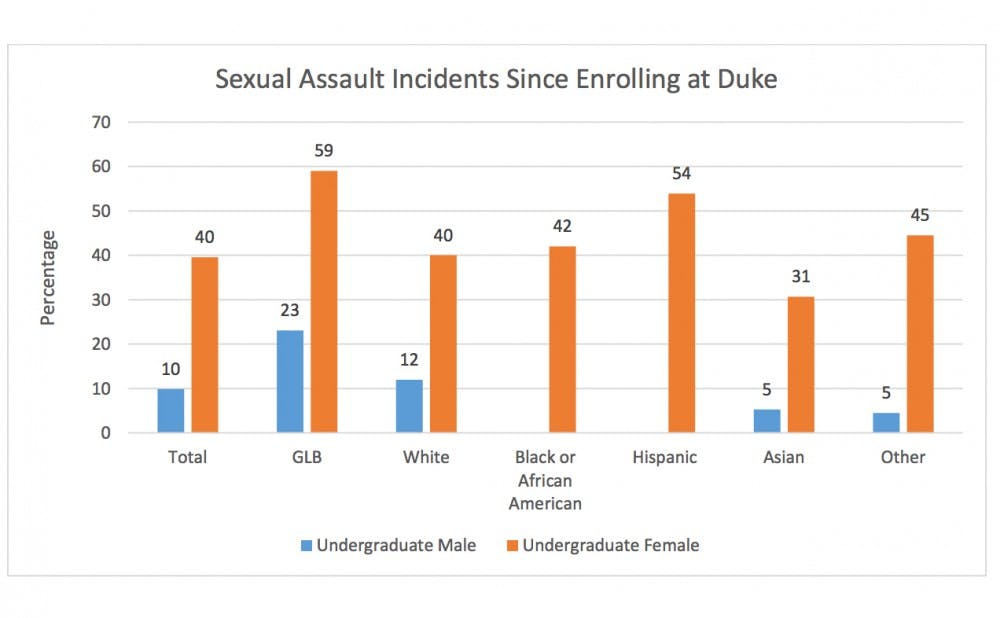According to a recent survey released by the University, 40 percent of undergraduate women at Duke and 10 percent of undergraduate men reported being victims of sexual assault since enrolling.
Sue Wasiolek, associate vice president for student affairs and dean of students, said the rates were "unacceptable."
Nationally, the percentage of women who experience sexual assault in college is estimated to be approximately 20 percent—making the Duke statistic two times higher than the national average for undergraduate females. Additionally, 10 percent of undergraduate males reported being a victim of sexual assault since enrolling at Duke, compared to national estimates placed at approximately six percent.
Although a majority of students in the survey reported feeling safe on campus and said that they thought the University cared about their safety, more than half of students reported that they still thought sexual assault was a big problem at Duke.
“For students to say that they feel safe and yet at the same time so many have fallen victim to sexual assault is an interesting question," Wasiolek said. "It speaks to the fact that the vast majority of what we’re talking about in this report is related to the individual experiences that students are having with others that they know, and maybe that’s one of the reasons that they are not necessarily correlating those experiences with overall safety."
African-American and Hispanic undergraduate women and gay, lesbian and bisexual undergraduate students reported the highest rates of sexual assault.
The most common locations for sexual assault incident were off campus—in places like Greek houses and "bars, pubs and restaurants." On campus, residence halls were the most frequently reported location of sexual assaults. Students in the survey said that alcohol and drug use was a factor in more than half of sexual assault incidents.
Most undergraduate victims of sexual assault reported that their perpetrator was a Duke student. In the majority of cases, it was someone victim already knew, with only 30 percent of female undergraduates reporting that their perpetrator was a stranger.
Despite the high reported prevalence of sexual assault, most male and female undergraduate students said that they understood the definition of sexual assault and consent.
Efforts should be made to assess whether students’ understanding of consent is accurate, Wasiolek noted, and then to ensure students’ behavior reflect their knowledge.
Only eight percent of undergraduate women who were sexually assaulted formally reported the incident to any official, but 85 percent of women who did report said that the official was helpful to them. Overall, undergraduate women reported more negative perceptions of how Duke treats sexual assault victims than undergraduate men and graduate men and women. More than half of undergraduate women said that Duke is not doing a good job of preventing sexual assault.
In the past few years, administrators and student activist groups have mainly focused on improving the sexual misconduct policy and reporting process, said senior Jessica Van Meir, co-president of student activist organization We Are Here Duke, co-founder of the coalition Duke Students Against Gender Violence and a member of the Sexual Misconduct Task Force.
“I think there’s been a lot of good improvements to the policy, but that’s after the fact [of sexual assault]. So now we’re trying to turn our efforts to preventing sexual assault in the first place,” she said.
The survey findings have been presented to the Sexual Misconduct Task Force, which consists of students, faculty and staff and is co-chaired by Larry Moneta, vice president of student affairs, and Howie Kallem, director of Title IX compliance. The task force, which meets monthly, is charged with making recommendations on sexual misconduct prevention and intervention policies.
Van Meir said that she hopes the “startling” statistics in the report will “shock students into action.” By educating themselves and intervening in bystander situations, students can help fight the problem, she noted.
Wasiolek agreed that it is important to engage as many people in the conversation as possible, particularly people who are less aware of the issue and groups who reported higher rates of experiencing sexual assault or harassment.
“[The University is] committed to finding answers for prevention,” she said. “These numbers are unacceptable.”
Correction: Howie Kallem is co-chair of the Sexual Misconduct Task Force, not Zoila Airall. The task force meets monthly. The Chronicle regrets the errors.
Get The Chronicle straight to your inbox
Signup for our weekly newsletter. Cancel at any time.

